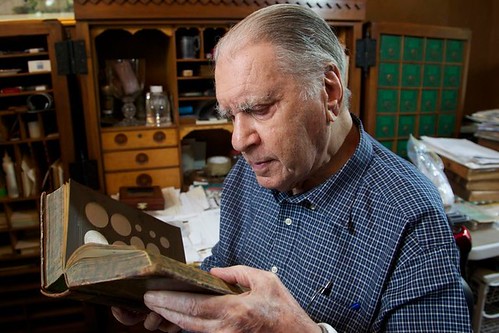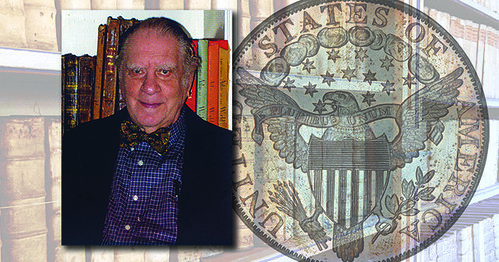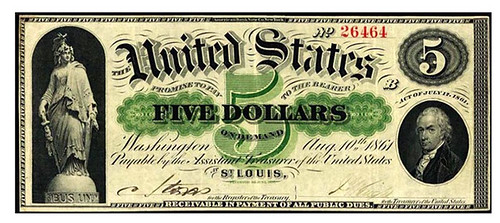
PREV ARTICLE
NEXT ARTICLE
FULL ISSUE
PREV FULL ISSUE
MORE ON LIFE OF ERIC P. NEWMANThe death this week of American numismatist Eric P. Newman has reverberated around the world. See our special issue this week for the original announcement. Here are more
articles and reactions gathered over the last few days. In the U.S., the most prominent coverage came from the New York Times. Here's a short except. -Editor
 It was just a strange old penny, a copper-nickel Indian Head minted in 1859, when the government was trying out different metals for one-cent pieces. A grandfather gave it to Eric Pfeiffer Newman in 1918, when he was 7, a little bonus for his nickel-a-week allowance. For almost a century, Mr. Newman called the fascinating old penny his first numismatic inspiration, a doorway to the past that took a boy from St. Louis into a life of curiosity, travel and adventure and made him one of America’s most distinguished authorities on the art and history of coinage and paper money. He went on to scour the United States and visit more than 150 countries to explore the relationships between money and the societies and cultures it served. He died on Wednesday at his home just outside St. Louis, in Clayton, Mo., where he had lived all his life. He was 106. To anyone who imagines that numismatists are hopeless romantics searching for coins in shipwrecks, musty attics and old curiosity shops, Mr. Newman was a composite antithesis: the author of books and scholarly articles and a consummate intellectual with an encyclopedic memory, a passion for history, the instincts of a relentless detective and the sharp eye of a trader in antiquarian treasures. He tracked down promissory notes issued by a wealthy Philadelphian that had secured his place in history as a major financier of the Revolutionary War and the national government in its fragile early days. He found 19th-century American gold and silver coins that matched French and Italian weights, and deduced that they were prototypes for a trans-Atlantic currency, a kind of Eurodollar that never succeeded. He discovered Ohio and Connecticut bank notes engraved with what were almost certainly John James Audubon’s earliest published illustrations of a bird: a meek little grouse, circa 1824, several years before the appearance of the first plates in his masterpiece ornithological portfolio, “The Birds of America.” He documented Benjamin Franklin’s central role in developing American currency by printing intricate leaf patterns to foil counterfeiters in the 1730s. He studied African-American influences on the nation’s money, notably that of Blanche Kelso Bruce, a former slave whose signature as Register of the Treasury appeared on all United States currency from 1881 to 1885, under Presidents James A. Garfield and Chester A. Arthur, and from 1897 to 1898, under President William McKinley. He wrote books on fakes: “The Fantastic 1804 Dollar” (1962, with Kenneth E. Bressett), about a coin actually struck in 1834 to make diplomatic gifts, and “The Secret of the Good Samaritan Shilling” (1959), about a bogus 1652 Massachusetts coin exposed by Mr. Newman as a 1750s imitation. In his dry wit, he called it “a muled restrike of a reproduction of an erroneous drawing, copied from a conjured illustration of a genuine coin.” To read the complete New York Times article, see: The article mangles a few numismatic facts. Not ALL of his collection was sold, and while he did at one time own all five 1913 Liberty Head nickels, he soon sold them to
concentrate his resources on what he felt were significant rarities. The proceeds at the time were far less than $3 million each.
The article is still an excellent one, doing a fine job of capturing the essence of its subject. Be sure to read the complete version online. -Editor Pablo Hoffman writes: A few words on reporter Robert D. McFadden of New York Times, the winner of the Pulitzer Prize for “Spot News Reporting, 1996:, "for his highly skilled writing and reporting on deadline during the year." He is known throughout the world of journalism for his many professional accolades, and for his well-written obituaries of notables, including Eric Newman’s. Here's an excerpt from Coin World. -Editor
 Renowned numismatist Eric P. Newman, who once owned all five examples of the 1913 Liberty Head 5-cent coin at the same time, died the afternoon of Nov. 15 at age 106. News of Mr. Newman's passing was communicated to the coin community by Leonard Augsburger, who is project coordinator for the Newman Numismatic Portal at Washington University in St. Louis. Net proceeds from the sales by Heritage Auctions, beginning in 2013, of select material from Newman's extensive numismatic collection (amassed over more than nine decades) has funded the numismatic research portal and other philanthropic endeavors, via the Eric P. Newman Numismatic Education Society. The Heritage sales have comprised material from early U.S. numismatics, including coins, paper money and patterns. Heritage’s most recent sale Nov. 3 of Newman's holdings included one of just four known examples of the 1861 Confederate States of America half dollar. Graded Proof 40 by Numismatic Guaranty Corp., the coin realized $960,000. The sale was its first public appearance at auction, as it had been off the market since Newman purchased it for $4,000 from the estate of Col. E.H.R. Green nearly 80 years ago. To read the complete article, see: Here's an excerpt from a piece by Dennis Tucker published on the Coin Update site. -Editor
 When I started working at Whitman Publishing in 2004, Eric P. Newman was already long established in many fields, including numismatics. He was in his early 90s at the time and going strong. A few memories: My first communication with Mr. Newman started in 2005, after he read an early draft of Q. David Bowers’s manuscript for what would become the Guide Book of Shield and Liberty Head Nickels. To say that his comments, edits, and recommendations were sharp would be an understatement. They were razor-sharp, gently but firmly communicated, full of wit, precision, and clarity. “Authoritative” is the word. He pointed out statements that were conjectural. He advised where clarification was needed. He corrected seemingly minute but actually significant errors of fact. He offered changes in wording to make the already strong text even stronger. At the time Dave’s ~150-page manuscript was just one of several that Mr. Newman was editing for other researchers. “Keep writing and keep numismatics hopping,” he told his longtime friend. Who else but Eric P. Newman could advise Dave Bowers thus! In December of that year Mr. Newman emailed Dave and several Whitman associates to clarify the dates of the Massachusetts colonial paper-money issues of 1690 and 1691—a complex subject that he explained with his usual authority and clarity. (His explanation would be folded into the manuscript for 100 Greatest American Currency Notes.) In this email, the elder statesman of numismatics illustrated his modesty and his approachable manner, inviting further questions and saying goodbye as “Eric to some of you and, for a little while, Eric P. Newman to the rest.” It wasn’t long before he was signing off as just “Eric” in his personal correspondence to me. Why do I now refer to him as “Mr. Newman”? I need to work on that! He was always friendly and welcoming, and would undoubtedly laugh at the formality. While his humor was fun and light-hearted, Mr. Newman’s scholarship always bore weight. In 2007 he offered important suggestions on the structure of Dave Bowers’s in-the-works Whitman Encyclopedia of Colonial and Early American Coins. He was a substantial guiding force in the book’s development, even from afar. Dave ended up dedicating the monumental book “to Eric P. Newman and his lifetime devotion to early American numismatics.” In 2008 we started talking about crafting a new edition of a hobby classic, The Fantastic 1804 Dollar. Mr. Newman and Kenneth Bressett began working on that book in 1959. Ken was already known as a serious numismatist, though he wasn’t yet identified as “Mr. Red Book” (that title, at that time, was for R.S. Yeoman). The Fantastic 1804 Dollar was finally released in 1962, and the dramatic circumstances of its publication are the stuff of hobby legend. With the 50th anniversary of the start of their collaboration approaching, and with 1804 dollars constantly in the news, I wanted to create a new edition for today’s hobby community. It was an honor to work with Newman and Bressett on the “Tribute Edition” Whitman published in 2009, marking the 50th anniversary of the start of their writing on these famous coins. Today Eric Newman may be gone, but he remains an active force in the hobby, art, and science of numismatics through the continuing work of his foundations, including the Eric P. Newman Numismatic Education Society (and its groundbreaking Newman Numismatic Portal), and of course through his voluminous published works, and the benchmarks he set for other researchers. The great writer, who always considered himself a student, also kept up to date with Whitman’s publications. It was my honor to send him a copy of every new book as it was published, for his library. He read them all, and continued to take interest of all aspects of the field, as he did when he started in numismatics as a youth. “Keep producing books galore,” he once told me. And more advice to Dave Bowers: “Don’t stop writing. Don’t retire. And keep your mind churning, as always.” I encourage every numismatist reading these words to continue Eric Newman’s legacy by taking that advice to heart. To read the complete article, see: Coin Week prepared a nice article which includes a list of the various awards and honors that Newman recieved in his long numismatic career. Here's an excerpt.
-Editor
 After Newman graduated from John Burroughs School, a private prep school in the suburbs of St. Louis, in 1928, he enrolled at the Massachusetts Institute of Technology (MIT). It was here that he met the legendary collector and Wall Street heir “Colonel” E. H. R. Green. As the story goes, Newman and some classmates were using a crystal shortwave radio to communicate with the expedition of Admiral Richard E. Byrd to the Antarctic but their equipment created a lot of static and frustration. When Col. Green found out about the problem his youthful numismatic friend was having, he gave Newman and his group free reign to use Green’s personal radio station based at Round Hill, Massachusetts. And not only does this story speak to the power of numismatic camaraderie that we in the hobby are often lucky to know for ourselves, but Newman and his friends even managed to save the life of one of the expedition members who was suffering from appendicitis at the South Pole! Col. Green came to MIT to thank them all personally, obviously very impressed with his numismatist friend. ... in 1936, Colonel Green died. Familiar with his friend’s collection, Newman wanted to purchase a particular 1861 $5 St. Louis Demand Note but heard no response from Chase National Bank, the executor of Green’s estate. Newman wrote again, emphasizing his personal connection to Green. This time the bank replied, but only to tell him that he would have to buy all 40 lots of Missouri notes in the collection. Undeterred, Newman mustered up the $600 appraised value of the notes from his still very supportive family. Upon this successful purchase, Newman told his mentor Burdette Johnson about it and the rest of the Green collection. Johnson then fronted Newman the cash to buy almost all of what remained – including the only five-known 1913 Liberty Head nickels. He let Newman keep whatever he wanted and took a selection of equal value for himself. To read the complete article, see: From Editor Ursula Kampmann of CoinsWeekly in Germany (November 16, 2017). -Editor
Last night we learned that 106 year-old Eric P. Newman has passed away. For all those who have not yet heard of him: Eric P. Newman is one of the most popular figures of US American numismatics. He
was born in 1911. With as many as two degrees in different academic disciplines – he held an Engineering degree from the MIT and a degree in Law from Washington University – he then became a
well-known lawyer and inventor who invested a share of his revenues in numismatics.
Over the last years, Heritage auctioned parts of his collection. The revenues were spent on the realization of what was the coin enthusiast’s vision: he wanted others to share his great passion. Eric P. Newman thus not only devoted the lion-share of his more than 100 books and articles to numismatic topics; Washington University has a Newman Money Museum, and the online available Newman Numismatic Portal offers a seemingly uncountable set of scans of numismatics sources that are otherwise hard to come by. The numismatic community needs people like Eric P. Newman. And it keeps bringing forth people like him. After all, coin collecting is more than a short-term investment or an irrelevant pastime. It’s an attitude to life. It’s the lived conviction that we are part of a history to which we owe that we are who we are and which obliges us to pass the best we have and know on to future generations. Eric P. Newman has lived this conviction. And for that, we are grateful to him. To visit the Coinsweekly web site, see: Here's a Coin Update article. -Editor
To read the complete article, see: To read the E-Sylum special issue, see:  Wayne Homren, Editor The Numismatic Bibliomania Society is a non-profit organization promoting numismatic literature. See our web site at coinbooks.org. To submit items for publication in The E-Sylum, write to the Editor at this address: whomren@gmail.com To subscribe go to: https://my.binhost.com/lists/listinfo/esylum All Rights Reserved. NBS Home Page Contact the NBS webmaster 
|